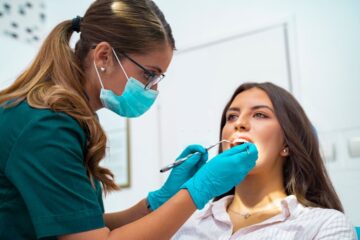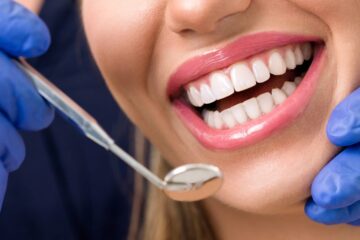Can Wearing a Retainer Help With Gingivitis?
Galloping through the annals of dental health, you might not immediately connect the dots between armour-like retainers and the battleground of gingivitis. Yet, as you’re navigating the twists and turns of oral hygiene, it’s worth considering whether this unassuming ally could be a knight in shining plastic for your gums.
Retainers, typically associated with the aftermath of braces, are designed to keep your teeth in line, but could they also play a role in the fight against gum disease? The link between retainers and gingivitis isn’t as straightforward as you might think; it involves a delicate balance of maintaining retainer cleanliness and understanding how oral appliances affect your overall gum health.
Stick around to uncover the intricacies of this relationship and what it could mean for your daily dental care routine.
Key Takeaways
– Gingivitis is a common form of gum disease caused by plaque buildup and can progress to periodontitis if left untreated.
– Proper cleaning and maintenance of retainers are essential to prevent bacterial accumulation and the development of gingivitis.
– Wearing retainers after orthodontic treatment helps maintain teeth alignment, prevent relapse, and support better oral hygiene.
– Regular dental check-ups are important to monitor oral health, detect early signs of gum disease, and ensure the proper fit and condition of the retainer.
Understanding Gingivitis
Gingivitis, a common and mild form of gum disease, causes inflammation and irritation of the gingiva, the part of your gum around the base of your teeth. It’s crucial to recognize that gum inflammation is often the result of plaque buildup, a sticky film composed primarily of bacteria. When plaque isn’t removed by daily brushing and flossing, it can harden into tartar, a calcified deposit that can further irritate your gums.
You should be aware that gingivitis is generally reversible with good oral hygiene. However, if left untreated, it can advance to periodontitis, a more severe gum disease that can lead to tooth loss. Early signs of gingivitis include redness, swelling, and bleeding of the gums, especially during brushing or flossing.
To mitigate gum inflammation, you must disrupt plaque buildup. This involves consistent oral care practices, including brushing twice a day, flossing daily, and using an antiseptic mouthwash. Additionally, regular dental check-ups and cleanings are indispensable in preventing and managing gingivitis. During these visits, any accumulated tartar can be professionally removed, which is something you can’t do at home.
Retainers and Oral Health
Retainers, commonly used after orthodontic treatment, play a significant role in maintaining oral health, but they also require meticulous care to prevent gum diseases such as gingivitis. They’re pivotal in preventing orthodontic relapse, ensuring teeth alignment remains as prescribed by your dental professional. However, if not cleaned properly, retainers can harbour bacteria and plaque, contributing to gingivitis.
To optimise your oral health while using a retainer, consider the following:
- Clean your retainer daily: Use a soft-bristled toothbrush with non-abrasive cleaner to remove plaque and bacteria.
- Rinse after meals: Minimise bacterial growth by rinsing your retainer with water immediately after eating.
- Regular dental check-ups: Maintain appointments with your orthodontist or dentist to monitor oral health and retainer condition.
Neglecting retainer hygiene can lead to bacterial accumulation, which may cause inflammation of the gums, a hallmark of gingivitis. Proper retainer care is essential not only to maintain teeth alignment but also to support periodontal health.
If you notice signs of gingivitis, such as red, swollen, or bleeding gums, consult your dental care provider promptly. They may recommend additional interventions to ensure your gums remain healthy while your teeth stay perfectly aligned.
Pros of Wearing Retainers
While ensuring your retainer is clean helps prevent gingivitis, it’s also worth noting the numerous advantages retainers offer in maintaining dental health post-orthodontic treatment. Retainers are crucial for stabilising your dentition after the active phase of orthodontic therapy. They work by maintaining the teeth in their corrected positions, preventing relapse and ensuring long-term results of orthodontic treatment.
Retainer materials are specifically chosen for their durability and biocompatibility to minimise the risk of allergic reactions. Common materials include acrylic, which is used in the construction of Hawley retainers, and thermoplastic materials used in clear aligners. Both types are designed to resist wear and tear, providing a barrier that helps protect the enamel from demineralization and abrasion.
Moreover, properly fitted retainers contribute to a stable occlusal relationship, which is the manner in which upper and lower teeth come together. A stable occlusion can mitigate issues like abnormal wear patterns and temporomandibular joint disorders. By preserving the alignment of your teeth, retainers also facilitate better oral hygiene, as straight teeth are easier to clean effectively, thereby reducing the risk of periodontal diseases, including gingivitis.
Retainers and Gum Disease
Despite their role in stabilising teeth post-orthodontic treatment, retainers can contribute to gum disease if not maintained properly. The plaque and bacteria that accumulate on retainer materials can lead to periodontal issues, including gingivitis. This inflammation of the gums can progress to more severe forms of gum disease if left unchecked.
To minimise your risk of gum disease while wearing a retainer, consider the following:
- Cleanliness: Adherence to a strict hygiene regimen, including thorough cleaning of the retainer, is paramount. Bacteria thrive on the biofilm that can develop on retainers, and these microbes are culprits in causing gum irritation and subsequent gingivitis.
- Material Sensitivity: Some individuals may have reactions to certain retainer materials, leading to inflamed gum tissue. If you notice signs of irritation, consult with your orthodontist about potential alternative materials that are biocompatible and less likely to provoke a negative response.
- Regular Check-ups: Dental professionals can detect early signs of gum disease and recommend appropriate interventions. They can also ensure that your retainer fits correctly, as an ill-fitting retainer can create pockets where bacteria accumulate, aggravating the gums.
Incorporating these practices into your oral care routine can help protect your gums from the adverse effects potentially caused by retainers.
Maintaining Retainer Hygiene
Understanding the importance of retainer cleanliness, let’s explore the specific steps you can take to maintain optimal hygiene and prevent gingivitis.
Retainer cleaning is crucial because bacterial accumulation on the device can exacerbate gum inflammation, contributing to gingivitis.
To inhibit bacterial growth, you should rinse your retainer with lukewarm water after each use. Brushing the retainer daily with a soft-bristled toothbrush and non-abrasive toothpaste can prevent plaque buildup. Avoid hot water, as it can warp the retainer’s shape, compromising its effectiveness.
For a deeper clean, consider soaking your retainer in a denture cleaner or a retainer-cleaning solution as recommended by your orthodontist. Ensure that the soaking duration aligns with product instructions to avoid damaging the retainer.
It’s imperative to clean the retainer case regularly as well, as it can be a reservoir for microbes. Use a mild detergent and rinse thoroughly before allowing it to air dry. Avoid airtight containers, which can promote a humid environment conducive to bacterial growth.
Lastly, schedule periodic check-ups with your dental care provider. They can assess your retainer’s condition, ensuring it remains free of cracks or deposits that could harbour bacteria, and provide professional cleaning if necessary.
Frequently Asked Questions
Can a Retainer Cause an Allergic Reaction That Might Affect Gum Health?
You may experience allergic symptoms if your retainer’s material isn’t safe and causes a reaction, potentially impacting your gum health. Always check for biocompatibility to prevent adverse effects on your oral tissues.
Are There Any Specific Retainer Materials Better Suited for Individuals Prone to Gingivitis?
Ever considered how retainer hygiene impacts your gum health? You’ll want to choose materials with high biocompatibility, as they’re less likely to provoke gingivitis in susceptible individuals. Always consult your orthodontist for tailored advice.
How Do Fluctuating Hormones, Such as During Pregnancy, Affect Retainer Use and Gingivitis Risk?
During pregnancy, hormonal changes can exacerbate gingivitis, necessitating vigilant dental care. Your retainer use must be consistent, but with heightened oral hygiene to mitigate the increased risk of hormonal gingivitis.
Can the Use of a Retainer Interfere With Other Dental Treatments Aimed at Controlling or Curing Gingivitis?
Could your retainer be a hurdle in gingivitis treatment? Maintaining retainer hygiene is crucial. You’ll need professional consultation to ensure it doesn’t disrupt evidence-based dental therapies for your gingivitis.
Is There a Difference in Gingivitis Risk Between Those Who Wear Permanent Retainers and Those Who Use Removable Ones?
You’re at a similar risk for gingivitis with both permanent and removable retainers. Prioritise retainer hygiene and regular dental check-ups to minimize gingival inflammation and maintain optimal oral health.
Conclusion
In conclusion, while retainers play a crucial role in maintaining dental alignment, they’re not a shield against gingivitis.
Imagine your oral cavity as a garden; retainers can’t prevent the weeds—consistent hygiene practices are key.
Brush and floss diligently, and keep your retainer clean to reduce bacterial buildup.
This adjunctive effort, alongside regular dental check-ups, will help you preserve both periodontal health and that straight, winning smile.





